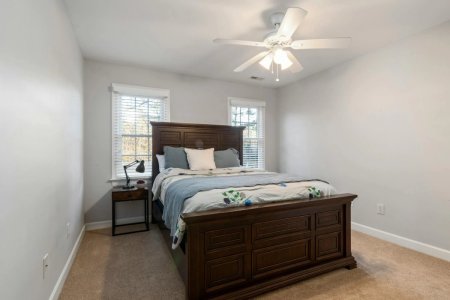Is your fan spinning the wrong way? This simple summer fix could save you $78
By
Veronica E.
- Replies 0
Summer heat doesn’t just test your patience—it can take a big bite out of your budget, too.
But before you reach for the thermostat, there’s one small, often-overlooked detail that could help you stay cool and save money: the direction your ceiling fan is spinning.
It might sound like a minor detail, but setting your fan the right way can put nearly $80 back in your pocket over the next few months.
Here’s how it works—and how to check if your fan is helping or hurting your summer energy bills.
Which way should your fan spin in summer?
Your ceiling fan isn’t just moving air around—it’s designed to help regulate how warm or cool you feel.
The direction it spins changes the effect.

In the summer, you want your fan to spin counterclockwise.
This pushes air downward, creating a breeze that cools your skin.
That airflow helps your body feel cooler, even if the room temperature stays the same.
As a result, you can raise your thermostat a few degrees without sacrificing comfort.
How much can you save?
According to recent estimates, the average household pays about $173 per month for electricity during summer.
Over three months, that’s $519.
By adjusting your fan to spin counterclockwise, you could reduce your energy use by up to 15%—which means saving about $77.85 over the season.
That’s enough for dinner out, a few rounds of golf, or even part of your next electric bill!
Also read: Don't overpay for electricity anymore! Discover 6 secret tricks to stay warm even in the priciest state!
How to tell if your fan is spinning the right way
Many fans default to the winter setting (clockwise), which pulls cool air up and circulates warm air down the walls.
Great for winter—not ideal for July.
Here’s how to check and fix it:
Still not sure? Just stand under the fan when it’s on.
If it feels like air is being pushed down on you, it’s set for summer.
If not, flip the switch and test again!
Also read: Could your weekends be energy-free? Here’s how some Americans are getting electricity at no cost
Why do fans have two settings anyway?
Fans are reversible because they serve two purposes.
In the winter, the clockwise setting gently moves warm air from the ceiling down the walls to warm the room.
In the summer, the counterclockwise setting pushes air down to cool you directly.
Using the right setting for the season can help you save money year-round—not just during the summer.
Also read: Cut $128.52 off your energy bill! Try this simple trick
Extra ways to cool your home (and save)
While you’re optimizing your fan, here are a few other energy-saving tips:
Is it okay to leave fans on overnight?
If you sleep better with a breeze, running a fan at night is generally more efficient than using the air conditioner.
Just remember—if no one’s in the room, turn it off.
And if you can cool your house overnight with fresh air, you’ll start the next day on a cooler note.
Before you touch the AC, take a look at your ceiling fan—it might be your easiest way to beat the heat and keep a little extra cash in your pocket!
Read next: Brace for impact: Find out why your electricity bill might skyrocket in June!

Have you checked your fan this summer? We’d love to know—did switching your fan direction make a difference? Have you noticed changes in your comfort or electric bill? Share your summer cooling tips and tricks in the comments below!
But before you reach for the thermostat, there’s one small, often-overlooked detail that could help you stay cool and save money: the direction your ceiling fan is spinning.
It might sound like a minor detail, but setting your fan the right way can put nearly $80 back in your pocket over the next few months.
Here’s how it works—and how to check if your fan is helping or hurting your summer energy bills.
Which way should your fan spin in summer?
Your ceiling fan isn’t just moving air around—it’s designed to help regulate how warm or cool you feel.
The direction it spins changes the effect.

A simple switch on your ceiling fan could help you stay cooler and save up to $78 this summer—just make sure it’s spinning the right way. Image Source: Pexels / Curtis Adams.
In the summer, you want your fan to spin counterclockwise.
This pushes air downward, creating a breeze that cools your skin.
That airflow helps your body feel cooler, even if the room temperature stays the same.
As a result, you can raise your thermostat a few degrees without sacrificing comfort.
How much can you save?
According to recent estimates, the average household pays about $173 per month for electricity during summer.
Over three months, that’s $519.
By adjusting your fan to spin counterclockwise, you could reduce your energy use by up to 15%—which means saving about $77.85 over the season.
That’s enough for dinner out, a few rounds of golf, or even part of your next electric bill!
Also read: Don't overpay for electricity anymore! Discover 6 secret tricks to stay warm even in the priciest state!
How to tell if your fan is spinning the right way
Many fans default to the winter setting (clockwise), which pulls cool air up and circulates warm air down the walls.
Great for winter—not ideal for July.
Here’s how to check and fix it:
- Turn off your fan completely.
- Look for a small switch on the base or motor housing—this controls the spin direction.
- Flip the switch so the blades spin counterclockwise.
- Turn the fan back on. If you feel a strong breeze blowing down, you’ve got it right.
Still not sure? Just stand under the fan when it’s on.
If it feels like air is being pushed down on you, it’s set for summer.
If not, flip the switch and test again!
Also read: Could your weekends be energy-free? Here’s how some Americans are getting electricity at no cost
Why do fans have two settings anyway?
Fans are reversible because they serve two purposes.
In the winter, the clockwise setting gently moves warm air from the ceiling down the walls to warm the room.
In the summer, the counterclockwise setting pushes air down to cool you directly.
Using the right setting for the season can help you save money year-round—not just during the summer.
Also read: Cut $128.52 off your energy bill! Try this simple trick
Extra ways to cool your home (and save)
While you’re optimizing your fan, here are a few other energy-saving tips:
- Use fans only where needed. They cool people, not rooms—turn them off when you leave.
- Open windows at night. Let in cooler air, then close them in the morning to trap it.
- Avoid heat-generating appliances. Run the oven, dishwasher, or dryer in the early morning or evening.
- Switch to LED bulbs. They give off less heat and use less energy.
- Seal doors and windows. Prevent warm air from sneaking in and cool air from leaking out.
Is it okay to leave fans on overnight?
If you sleep better with a breeze, running a fan at night is generally more efficient than using the air conditioner.
Just remember—if no one’s in the room, turn it off.
And if you can cool your house overnight with fresh air, you’ll start the next day on a cooler note.
Before you touch the AC, take a look at your ceiling fan—it might be your easiest way to beat the heat and keep a little extra cash in your pocket!
Read next: Brace for impact: Find out why your electricity bill might skyrocket in June!
Key Takeaways
- Setting your ceiling fan to spin counterclockwise in summer can save you up to 15% on your energy bill, which could add up to around $78 over three months.
- Many people don’t realize ceiling fans are reversible, with a simple switch allowing you to change the direction for either summer cooling or winter warmth.
- Running your ceiling fan the wrong way during summer makes the cooling effect less efficient, potentially increasing your reliance on air conditioning and driving up costs.
- Additional ways to save on energy bills include using outside air to cool your home overnight and being mindful of leaving fans or air conditioners running unnecessarily.
Have you checked your fan this summer? We’d love to know—did switching your fan direction make a difference? Have you noticed changes in your comfort or electric bill? Share your summer cooling tips and tricks in the comments below!






